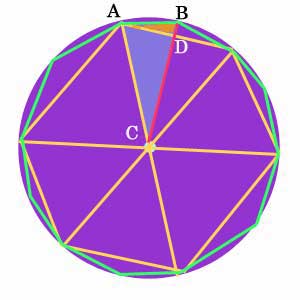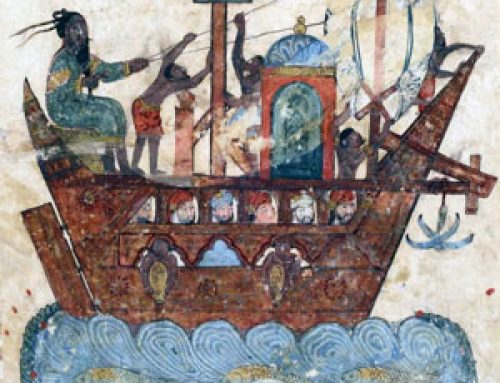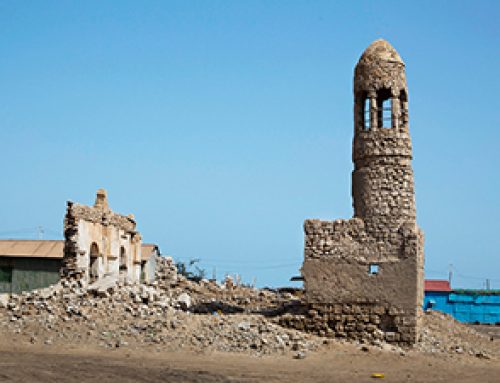
African math: Lebombo tally stick (35,000 BC)
The first tally sticks
African people were the first people anywhere in the world to use counting to keep track of their things, or maybe to keep track of time. Around 35,000 BC, somebody in South Africa made the earliest known counting stick, or tally stick, and left it in Lebombo Cave. Somebody cut 29 notches into the stick: the first African math.
Early South Africa
African science and inventions
All our Africa articles

Ishango Tally Stick
We don’t know what they were counting. Some people think maybe they were counting the days from one full moon to the next full moon, or the days between a woman’s periods, but it could just as well have been 29 people, or 29 baskets of nuts, or something else. But we can see that by 35,000 BC people in South Africa had the idea of keeping records by making marks.
East African history
Further north, in East Africa, people were also using tally sticks. About 20,000 BC, somebody at Ishango, at the head of the Nile River, made another tally stick. This one has groups of marks. Possibly someone used the same stick to keep track of a bunch of different things. Or, maybe the person was doing some kind of math, or keeping some kind of calendar.
Counting with clay tokens
Around 7000 BC, people in Egypt and further south in Sudan began to use clay tokens to count things. They probably got the idea from West Asia, where people began using tokens earlier.
West Asian numbers
Math in West Asia
Writing and numbers in Egypt
By 3000 BC, people in Egypt were using hieroglyphs to write down very large numbers. Soon afterwards, they were also using geometry to figure out how to build the Pyramids.
Egyptian math and science
Who built the Pyramids?
Euclid and geometry

A cone intersecting a plane
As the school and university system developed in Egypt, more and more young men – and some women – went to Egypt from other parts of Africa and from West Asia and Europe to study, as Thales is supposed to have done in the 600s BC.
Egyptian universities
Who was Euclid?
A geometrical proof
About 300 BC, the Greek pharaoh Ptolemy started the great University at Alexandria, and even more students and scholars came to Egypt to study and to discuss math problems with each other. Euclid wrote a textbook about geometry that would be used in schools for more than two thousand years.
Eratosthenes and Archimedes
Eratosthenes, who was born in Libya about 276 BC, came to Alexandria and invented an efficient way to discover all the prime numbers in a set of whole numbers. Archimedes also studied at the University of Alexandria. He worked on getting a more accurate value for pi, and wrote a proof for calculating the circumference of a circle, among other things.
Who was Eratosthenes?
What about Archimedes?
The circumference of a circle
Indian math and science
Archimedes, and other mathematicians at the University of Alexandria, may have been in touch with Indian mathematicians at the Buddhist University of Nalanda.

African math: Finding the circumference of a circle
Indian mathematics
When Egypt was under Roman rule, the astronomer Ptolemy worked there, working out mathematical formulas using trigonometry to predict the movement of the planets. The last important Roman teacher and researcher in Alexandria was Hypatia, who worked on proving things about the geometry of cones and what happened when a cone was intersected by a plane. In 415 AD angry Christians killed Hypatia (hi-PAY-sha) because she would not become a Christian.
Who was Ptolemy?
Egypt under Roman rule
Indian numbers, zero, and algebra
By the 700s AD, African mathematicians were excited about new ways of writing numbers that they learned from Indian mathematicians. At Kairouan (modern Tunisia), in the 800s AD, Ab Sahl al-Qayrawn wrote a book called the “Book on Indian Calculation” that explained how to use zero as a place-holder. Zero made it much easier to do math.
Indian numbers and zero
Medieval Islamic math
What is algebra?
Soon most people in North Africa and East Africa used the Indian number system. The combination of Egyptian geometry with Indian numbers led to many new mathematical ideas. In the 1100s, al-Qurash worked on algebra, and wrote a commentary on the work of the Egyptian mathematician Abu Kamil. Al-Qurash also invented a new method for reducing fractions. Al-Qurash died in 1184 AD. Samau’al al-Maghribi, a Jewish convert to Islam, took steps towards inventing inductive proofs – showing that a statement true for one number is also true for all numbers.
Al-Hassar and fractions
About the same time, another North African mathematician, al-Hassar, developed the modern way of writing fractions, with a bar separating the top from the bottom, like 1/2 or 2/7. Al-Hassar also wrote textbooks in Arabic about how to add whole numbers and fractions, how to calculate square roots and cube roots, and prime numbers.
More about fractions
And prime numbers
Fibonacci and African math
These are probably the books that the European mathematician Fibonacci used when he learned math in North Africa, to bring back to Europe and teach people there.
Math in medieval Europe
Also in the 1100s AD, Ibn al-Yasamin, a black Berber mathematician from Marrakech, wrote about how to use the new Indian number system in geometry, to calculate areas. Many mathematical books travelled south from Marrakesh and Kairouan to Timbuktu (in modern Mali), so that these algebraic ideas were also known there. Some of the scholars in Timbuktu must have been mathematicians, but nobody knows their names or their work.
West African mathematics
Not all Africans used Indian numbers. Around 1000 AD, people in West Africa were using a number system which was partly in base ten and partly in base twenty. For instance, in order to say “50”, Yoruba people said “Twenty times three, take away ten”. Or to say “318”, people said “400-(20×4)-2”. The Indian system expressed all of their numbers using addition, as we do (twenty+four), but Yoruba (your-OO-bah) people in West Africa also used subtraction to express numbers, the way we say “ten minutes to four.”
Medieval West Africa
History of money
What is an abacus?
People in West Africa used cowrie shells on strings of forty shells as a kind of abacus. In the 1200s AD, Ibn Muncim and Ibn al-Banna of the Marinid kingdom (modern Morocco) did some research on the use of number systems other than base ten. Were they trying to coordinate West African and North African mathematics?
Ibn al Banna and al Qalasadi
Ibn al-Banna also continued al-Hassar’s work on African math, writing about continued fractions and improving methods of writing algebraic equations. In the 1400s, Al-Qalasadi in turn continued Ibn al-Banna’s work, first in Muslim Spain and then under Hafsid rule (in modern Algeria and Tunisia).
The Little Ice Age
Medieval African environment
Medieval African economy
Al-Qalasadi worked to find clearer, more efficient ways of writing algebraic equations, using symbols (as we do) instead of using words. But by the late 1400s, a severe drought weakened Africa’s economy. As Europe got richer, the biggest universities were there, and African mathematicians started to travel to Europe to work, instead of going to Cairo.
Did you find out what you wanted to know about African math? Let us know in the comments!



